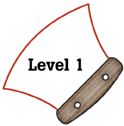
Alaska Science
Key Element A6
A student who meets the content standard should understand that forces of nature cause different types of motion, and describe the relationship between these forces and motion (Motion).
 |
Alaska Science A student who meets the content standard should understand that forces of nature cause different types of motion, and describe the relationship between these forces and motion (Motion). |
|
Performance Standard Level 1, Ages 5–7
|
|
|
|
Sample Assessment Ideas
|
|
|
Expanded Sample Assessment Idea
|
|
Procedure Students will:
Reflection and Revision
|
Levels of Performance |
||
|
Stage 4 |
Student work is complete and shows detailed evidence of the transfer and extension of knowledge related to how a push or pull changes the position or motion of an object. The student creates at least four complete sets of marble path diagrams that are clearly labeled, tests several marble variations (size, material, starting position), and always includes the repeat experiment. The student examines class data, identifies and explains patterns of motion for different marbles, and designs a method to deliver a uniform push for each marble roll. | ||
|
Stage 3
|
Student work is complete and shows some evidence of the transfer or extension of knowledge related to how a push or pull changes the position or motion of an object. The student creates at least two sets of marble path diagrams that are labeled, tests several marble variations (size, material, starting position), and includes the repeat experiment although aspects of the diagrams may be unclear. The student examines class data, identifies patterns of motion for different marbles, and designs a method to deliver a similar push for each marble roll. | ||
|
Stage 2
|
Student work may be incomplete and show little evidence of knowledge related to changes in the position or motion of an object. The student creates marble path diagrams that are incomplete or lack labels. The student may attempt to design a method to deliver a similar push for each marble roll. | ||
|
Stage 1
|
Student work is mostly incomplete and contains misconceptions related to the position or motion of an object. Marble path diagrams, if included, are incorrect or not labeled. Attempts to design a method to deliver a push for each marble roll may be inappropriate to the game or not work. | ||
Standards Cross-References
|
||
|
National Science Education Standards The position of an object can be described by locating it relative to another object or the background. (Page 127) An object’s motion can be described by tracing and measuring its position over time. (Page 127) The position and motion of objects can be changed by pushing or pulling. The size of the change is related to the strength of the push or pull. (Page 127) |
Benchmarks Things move in many different ways, such as straight, zigzag, round and round, back and forth, and fast and slow. (Page 89) The way to change how something is moving is to give it a push or a pull. (Page 89) |
|
Table of Contents | Return to Alaska Native Knowledge Network